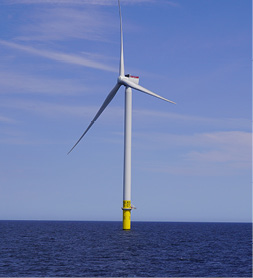By Killian Duborg, Connecticut communications specialist

Wind turbines of the South Fork Wind Farm, off Montauk Point, NY
As a new Congress and state legislative sessions start, it’s more important than ever that we are all conscientious consumers of information. With energy issues high on the agenda, you will likely hear a variety of perspectives. Unfortunately, misinformation spreads easily, even among well-meaning individuals.
One topic particularly prone to myths and misunderstandings is offshore wind energy. Well-sited offshore wind is a safe, proven, reliable, and cost-effective energy solution that’s essential to the Northeast region’s transition to clean energy. Let’s set the record straight by debunking some of the most common misconceptions about this renewable energy source.
Myth #1: Offshore wind farms harm marine mammals like whales.
Reality: Offshore wind poses far fewer risks to local marine life than the fossil fuel energy sources it is replacing.
According to NOAA, there is no scientific evidence linking offshore wind development to whale deaths or strandings. While construction does cause sonic disturbances, they are carefully managed to protect nearby marine life:
· High-frequency, low-energy sonar used for surveying seabed surfaces dissipates quickly and does not harm marine mammals.
· The sounds of driving pilings during turbine installation and construction are mitigated through protective measures like bubble curtains and seasonal restrictions.
Marine biologists have concluded that neither of these activities causes serious injuries to sea mammals, but to take extra care, protective measures are in place preventing surveying while any mammals are nearby. Oil and gas ocean exploration uses more powerful sonar to penetrate deep into the rock below the seabed, causing danger to sea creatures in a wider radius during surveying. Compared to the extensive environmental toll of oil and gas exploration, extraction and spills, offshore wind is a far safer choice for marine ecosystems.
Myth #2: Offshore wind turbines frequently lose their blades, posing risks to humans and wildlife.
Reality: Blade failures are extremely rare and less hazardous than the accidents associated with fossil fuels.
Blade failures, while unsightly, are less frequent and come with fewer risks to humans and wildlife than the oil spills associated with fossil fuel energy sources they are replacing. With approximately 70,000 wind turbine blades in operation around the U.S., only about 18 failures happen per year.
Turbine blades are made of the same non-toxic materials as boat hulls and can be cleaned up quickly with minimal impact. By contrast, fossil fuel failures like oil spills and gas leaks release harmful substances that devastate ecosystems for years and contribute significantly to climate change.
Myth #3: Offshore wind will make electricity more expensive.
Reality: Offshore wind can address New England’s winter reliability issues.
Offshore wind produces the most energy in the winter when natural gas supplies are constrained by the competing demands of power generation and home heating. These constraints currently require costly imports of liquified natural gas and oil to meet winter energy demands. Offshore wind provides a cost-effective alternative when it’s needed the most. Analysis by the Union of Concerned Scientists has found that meeting the New England states’ existing targets for offshore wind would have virtually eliminated the demand-driven risk of a winter blackout while lowering costs.
Myth #4: Offshore wind farms have a short lifespan.
Reality: Offshore wind turbines are built to last, with lifespans comparable to traditional power plants.
The lifecycle of modern commercial wind turbines is 20-25 years, similar to a natural gas power plant (about 22 years). They are also efficient and weather-tolerant. According to National Grid, offshore wind farms operate year-round in windspeeds from 7 to 56 miles per hour, and are designed with safety features that enable them to withstand extreme wind conditions like hurricanes.
The Bottom Line
Offshore wind is a safe, reliable, and cost-effective energy solution that’s essential for our transition to clean energy. By separating fact from fiction, we can ensure informed decision-making and accelerate progress toward a more sustainable future.
Save the Sound works across the Long Island Sound region to protect the Sound and its rivers, fight climate change, save endangered lands, and work with nature to restore ecosystems. More info at savethesound.org. Read more about Offshore Wind on our blog. ■




